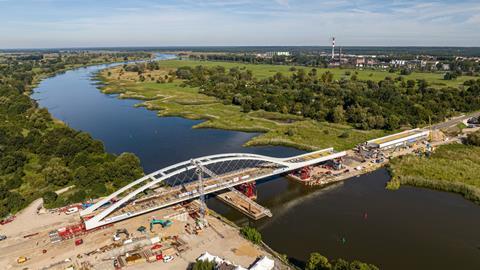Heavy lift and transport engineering provider Mammoet has successfully completed the installation of the Oder Bridge on the German-Polish border in Küstrin.
The 2,100-tonne, 180 m-long railway bridge was assembled on the German side of the Oder River and moved as a whole structure into its final position. Mammoet said this method allowed for minimal disruption to the rail network.
Koen Brouwers, project manager at Mammoet, explained: “Most bridges are floated into place using a combination of Mammoet SPMTs, launching plates and a pontoon. However, the use of a pontoon here was not possible due to the shallow, and changing, water levels of the river. Using a large crane, capable of positioning loads with a long reach, was also not feasible due to the weight and length of the bridge.”
For this project, the bridge was jacked up to a height of 2 m before SPMTs took over to move the structure to the edge of the river where it was positioned over the first of five temporary supports. The bridge was then launched using a combination of bespoke launching plates and strand jacks that pulled the structure horizontally until it reached the next temporary support. This process was repeated until the bridge reached the opposite side of the river.
Next, the SPMTs on the rear of the bridge were removed and skid shoes were installed to slide the bridge into its final position. At this point, climbing jacks took over the load, allowing the temporary supports to be removed and the bridge to be lowered down to its final resting height. Around 45 truckloads of heavy equipment were mobilised for this project, including 96 axle lines of SPMTs, 26 launching plates, 10 climbing jacks and two strand jacks.
One of the most challenging aspects was the risk of deforming the bridge’s structure during the launch process. Jack van der Vloet, lead engineer at Mammoet, said, “It’s a big bridge and wind loads had to be considered. It has a large deflection, so the launching plates had to be modified. Typically, they swivel in two directions; however, in this case they had to swivel 360 degrees.”
Custom skidding equipment, with retrofitted spherical bearings on launching plates, ensured multidirectional movement. Controlled weight distribution on towers and cylinders facilitated a smooth launch.
Mammoet said that moving bridges as a complete structure allows for parallel work in the preparation phase, while realising time savings during execution stages. Uwe Richter, senior sales manager at Mammoet, explained: “It is very important to involve Mammoet at an early stage to support the preparation phase with technical and feasibility studies. This way, we can investigate the different execution options and decide on the best solution with the customer.”

















